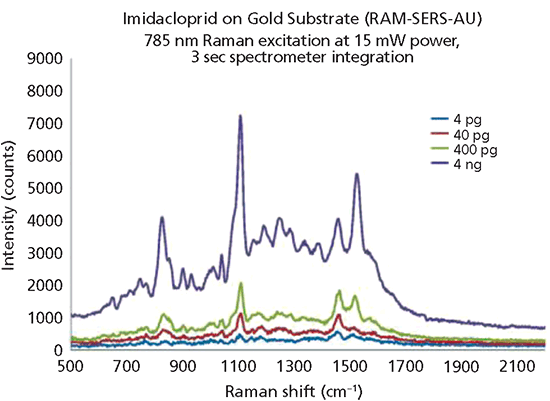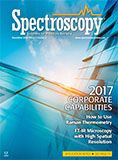Pesticide Detection Using SERS Techniques
In this application note, we evaluate the effectiveness of surface enhanced Raman spectroscopy (SERS) to measure trace levels of imidacloprid, one of a class of insecticides linked to honeybee loss.
In recent years, high rates of honeybee loss have prompted investigation by government regulators and other researchers. Early in 2016, the U.S. Environmental Protection Agency cited the insecticide imidacloprid as a threat to commercial honeybee colonies (1). Imidacloprid is widely used for pest control in agriculture, turf management and home protection applications.
Measurement Conditions
We tested the effectiveness of Ocean Optics gold and gold-silver nanosponge substrates, the former using 785 nm as the Raman laser excitation wavelength and the latter using 638 nm as the excitation wavelength. For the 785 nm Raman excitation setup we used a QE Pro-Raman spectrometer and for 638 nm excitation we used the IDRaman reader. Both configurations also included the Raman laser, a Raman probe and a sample holder.
For the measurements using gold substrates we prepared 1000 ppm, 100 ppm, 10 ppm and 1 ppm solutions of imidacloprid in acetone, added 10 µL of each solution per substrate, and let the substrate dry completely. For solutions preparation, faster-drying acetone is a better choice than water.
For the gold-silver nanosponge substrate measurements we prepared a 100 ppm solution of imidacloprid in acetone, added 10 µL of the solution per substrate, and let the substrate dry completely.
Experiment Results
We made a series of measurements using the gold (AU) substrates, in a setup with 785 nm Raman laser excitation at 15 mW of power and the spectrometer integration time set for 3 s (Figure 1). The gold substrates work best for imidacloprid concentrations >4 pg, primarily because the gold substrates have a stronger background signal, making lower concentration measurements challenging.

For very low level imidacloprid concentrations, our new gold-silver (SP) nanosponge substrates are most effective. These substrates are based on a plasma-phase deposition of the gold-silver alloy onto a unique glass surface, and are distinguished by high sensitivity with low background noise. The low background noise makes it easier to discern Raman peaks at very low concentration levels. To test this, we used the gold-silver substrates in a setup with 638 nm Raman excitation at 21.2 mW of power and the spectrometer integration time set for 1 s (Figure 2). Figure 2: Gold-silver nanosponge substrates have less background signal, making them a good choice for measuring very low concentrations of insecticides such as imidacloprid.
The lowest imidacloprid concentration we measured was 4 pg, which converts to 0.4 ppb. This is well within the 25 ppb concentration level that the U.S. EPA reports is harmful to honeybee populations.
Summary
In our imidacloprid measurements, we observed some differences in Raman peaks between substrates, most likely the consequence of different binding mechanisms of the analyte with the substrate material (nanoparticles for the gold and thin film for the gold-silver alloy), but also because the chemistries enhance certain transitions differently. In addition, some molecules will exhibit shifts in their Raman peaks depending on how they are oriented on the SERS-active surface.
As our testing has demonstrated, SERS substrates are a viable option for trace level detection. And, unlike many existing SERS products on the market, Ocean Optics SERS substrates are easy to use, affordable and can be mass produced with high repeatability for routine deployment in the laboratory or field.
Reference
(1) "Pesticide is threat to bees, EPA says," Los Angeles Times, January 7, 2016.

Ocean Optics
830 Douglas Ave., Dunedin, FL 34698
tel. (727) 733-2447, fax (727)733-3962
Website: wwwOceanOptics.com

Newsletter
Get essential updates on the latest spectroscopy technologies, regulatory standards, and best practices—subscribe today to Spectroscopy.